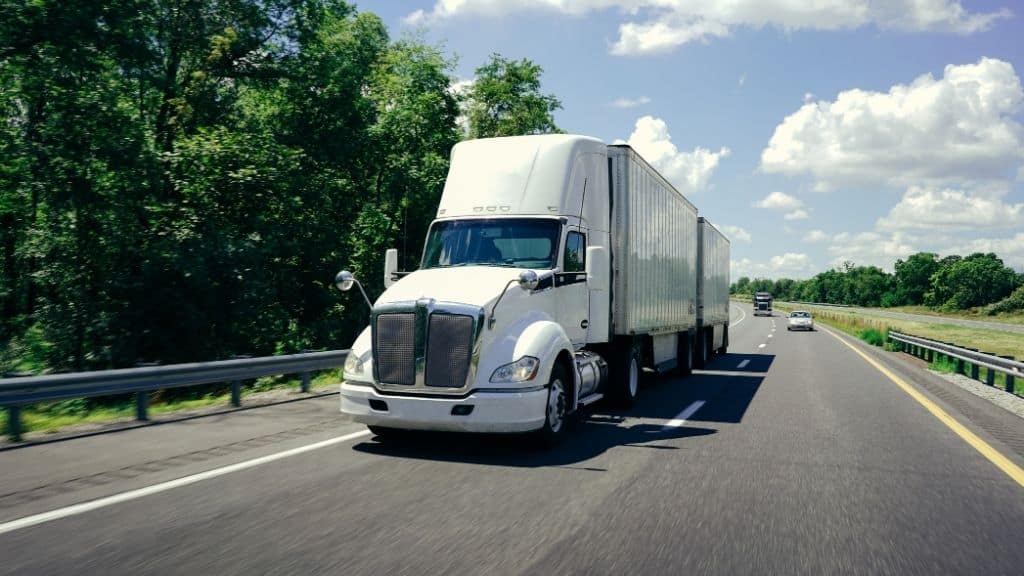Paula

Table of Contents
What are the ten key road transport regulations you need to know to keep your logistics operations smooth and compliant across Europe? Road transport logistics is not just about moving goods from point A to point B; it’s about navigating a complex web of rules that ensure safety, sustainability, and efficiency. In this article, we are going to summarize the main 10 road transport regulations that you have to consider when managing international logistics. Understanding these key rules is essential for ensuring compliance, safety, and efficiency in cross-border transport
1. Driving Times and Rest Periods: Prioritizing Safety on the Roads
When transporting cargo internationally, there are strict road transport regulations for drivers since driver fatigue is a significant risk in the logistics sector. The EU enforces these rules to ensure road safety and prevent accidents. Drivers can drive up to nine hours daily, with an option to extend to ten hours twice a week. After every 4.5 hours of continuous driving, a 45-minute break is mandatory, which can be divided into two segments (15 minutes followed by 30 minutes) for added flexibility.
To further enhance safety, weekly driving time is capped at 56 hours, with a maximum of 90 hours over two consecutive weeks. Tachographs play a vital role in this framework, recording driving times, breaks, and rest periods to ensure compliance. These road transport regulations are not just about protecting drivers but also safeguarding other road users, making roads more secure and predictable for everyone.
More information on driving time and rest periods is available here.
2. Vehicle Regulations: Standards for Safety and Sustainability
European road transport regulations also standardize vehicle specifications to maintain safety and reduce environmental impacts. Trucks must adhere to maximum width limits of 2.55 meters, except for refrigerated trucks, which can be 2.60 meters wide due to the extra insulation required for maintaining cargo temperature. The width is measured excluding side mirrors, which can add 20–30 cm on each side, bringing the total width to approximately 2.95 to 3.05 meters when included. Components such as tire pressure gauges, snow chains, mudflaps, and lighting equipment are also excluded from the width measurement.
In addition to these physical parameters, stringent emission standards, such as Euro 6, are a key aspect of road transport regulations aimed at curbing pollution. Regular maintenance and the use of advanced safety systems are mandatory, ensuring the reliability of vehicles and contributing to safer roadways across Europe.
Learn more about vehicle dimensions and standards.
3. Streamlined Customs Procedures for Efficient Cross-Border Transport
For logistics providers navigating international routes, customs compliance is a key aspect of road transport regulations. The TIR (Transports Internationaux Routiers) system simplifies customs procedures, facilitating quicker transit times. Within the EU Single Market, goods move freely without customs checks or tariffs, significantly reducing paperwork and making cross-border road freight seamless. However, businesses must adhere to VAT compliance, recording transactions in line with local tax regulations. Goods must also meet EU standards for product safety and quality control.
For transport to non-EU countries in mainland Europe, such as Norway or Switzerland, customs declarations are mandatory, detailing the shipment’s contents, value, and origin. Export documentation is managed through the EU’s Export Control System (ECS), often using the Single Administrative Document (SAD) or electronic customs forms via the Automated Export System (AES). Additionally, goods entering these non-EU countries may be subject to duties and VAT, with border checks performed to confirm compliance and collect applicable taxes. These processes are integral to ensuring alignment with road transport regulations across various jurisdictions.
Explore more about customs and transit systems.
4. Special Rules and Restrictions Across Europe
Road transport regulations often vary by country, imposing additional requirements on logistics operators. Sunday and holiday driving bans for heavy vehicles are common in some regions to reduce congestion. Seasonal restrictions, such as mandatory snow chains in winter, are enforced in areas prone to harsh weather, particularly in mountainous regions where icy roads pose significant risks. Furthermore, speed limits for trucks differ depending on road types—for instance, trucks may face lower limits on rural roads compared to highways. It’s also important to note that some countries enforce nighttime driving bans in urban areas to minimize noise pollution and disturbances. Adhering to these varied road transport regulations is essential for smooth and compliant operations across Europe.
Discover more about special rules for truck drivers in Europe.
5. Exploring the European Modular System (EMS) and Longer Heavier Vehicles (LHVs)
Due to sustainability goals and the need to reduce emissions, some European countries have implemented special road transport regulations that allow the circulation of larger vehicles, such as those under the European Modular System (EMS). These vehicles can carry significantly larger volumes of goods, reducing the number of trips required and lowering overall emissions. Countries like the Netherlands, Sweden, and Finland have embraced these regulations, recognizing their environmental and logistical benefits.
However, not all roads are equipped to handle these larger vehicles. Infrastructure must include reinforced roads and bridges, as well as optimized routes to ensure safe passage without causing damage. Since many countries have not yet upgraded their infrastructure, road transport regulations on permissible vehicle sizes vary significantly. This lack of standardization poses challenges for cross-border operations, making it essential for logistics providers to understand and comply with each country’s specific rules.For more detailed information on the dimensions, regulations, and benefits of EMS and LHVs, you can explore TRALERT’s comprehensive guide.

6. Harmonized Cross-Border Transport Regulations
Another critical component of road transport regulations that impacts cross-border transport is the EU Mobility Package I, adopted in July 2020. This comprehensive framework aims to improve working conditions for drivers, enhance road safety, and ensure fair competition among transport operators. Key aspects of the package include Regulation (EU) 2020/1057, which addresses salary equalization and working conditions for drivers across borders, and Regulation (EU) 2020/1054, which provides clearer guidelines on driving and rest times. Additionally, Regulation (EU) 2020/1055 revises market access rules, including stricter enforcement of cabotage operations to prevent unfair competition.
The Mobility Package also seeks to reduce illegal practices and foster sustainability by promoting efficient logistics operations. These harmonized road transport regulations play a pivotal role in streamlining operations and ensuring consistent standards across Europe.
For more detailed insights, you can visit the European Commission’s Mobility Package page.
7. Driver Qualifications and Training: Building Competence and Compliance
The qualifications and training of drivers are vital components of road transport regulations. Key requirements include:
- Licenses and Certifications: Drivers must obtain appropriate licenses for heavy vehicles, such as the CE category for articulated lorries.
- Periodic Training: Regular training, such as the Certificate of Professional Competence (CPC), is mandatory to ensure drivers remain informed about the latest regulations and safety protocols.
- Language Proficiency: Basic language skills are crucial for effective communication during international operations, especially when navigating cross-border routes.
- Health and Fitness Standards: Drivers must meet specific health and fitness requirements, including regular medical checks, to ensure they are physically capable of handling long hauls.
- Knowledge of Regulations: Understanding road transport regulations, such as tachograph usage and driving/rest time limits, is essential for compliance.
These requirements ensure that drivers are well-prepared to meet the demands of modern logistics operations while maintaining safety and compliance standards.
8. Technology: A Game-Changer for Compliance and Efficiency
Advancements in technology are revolutionizing the road transport sector by improving efficiency, compliance, and safety. Digital tachographs and electronic logging devices automate the tracking of driving hours, rest periods, and adherence to road transport regulations, significantly reducing administrative burdens for drivers and operators. Route planning software leverages real-time traffic data to optimize delivery schedules, reducing delays and fuel consumption.Additionally, real-time monitoring systems provide detailed insights into vehicle performance and cargo conditions, allowing for proactive maintenance and better cargo security. Innovations such as GPS tracking, predictive analytics, and IoT-enabled devices are further transforming logistics, enabling companies to streamline operations while maintaining full compliance with road transport regulations and enhancing customer satisfaction
9.Load Regulations: Ensuring Safe and Secure Transport
Cargo handling is another critical area governed by strict road transport regulations. Proper securing of loads prevents movement during transit, ensuring safety for both the driver and other road users. The transport of hazardous materials is subject to the ADR agreement, which outlines stringent guidelines for classification, packaging, labeling, and documentation to ensure safe handling.
Additionally, weight distribution and axle load management are crucial for maintaining vehicle stability, reducing the risk of accidents, and minimizing road damage. Drivers must also be aware of maximum load capacities to avoid penalties and ensure compliance with national and international road transport regulations. For additional tips on effective cargo handling and securing, visit Mtonroad’s guide.
10.Future Trends: Shaping the Road Ahead
The road transport industry is on the brink of significant transformation. The EU Mobility Package aims to enhance working conditions for drivers and ensure fair competition by updating key road transport regulations. Emerging technologies, such as autonomous vehicles and platooning, promise to revolutionize logistics, while sustainability initiatives focus on reducing carbon emissions through alternative fuels and innovative practices.
At Portex Logistics, we specialize in providing seamless road transport solutions that comply with all European road transport regulations, ensuring your cargo reaches its destination safely and on time. Our expert team stays up-to-date with the latest legal requirements and technological advancements, allowing us to offer optimized and compliant logistics services.
Whether you need assistance with cross-border transport, customs procedures, or compliance with vehicle and driver road transport regulations, Portex Logistics is your trusted partner in navigating the road transport landscape. Let us help you achieve operational efficiency while staying fully compliant with European standards.
Wondering how to keep your trucks moving while staying compliant with driving regulations? Discover how the Double Crew system can reduce transit times while staying compliant.
